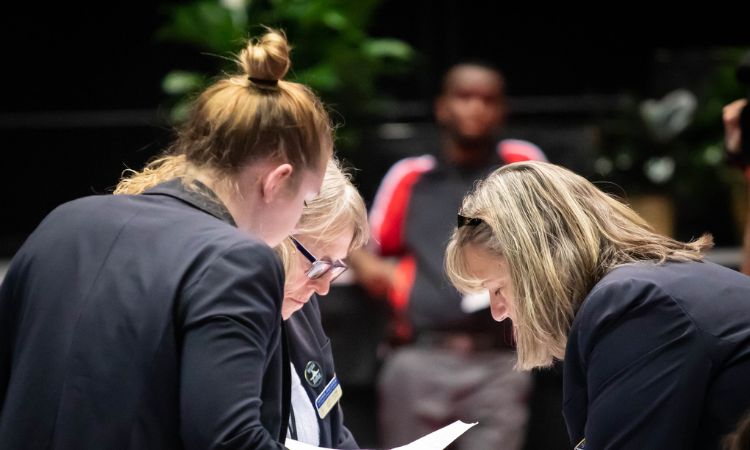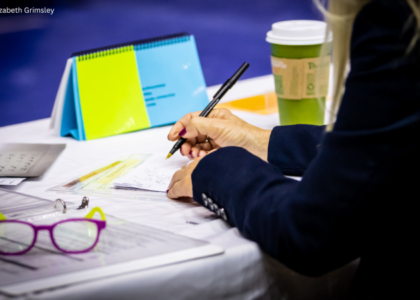Beam can be one of the most nerve-wracking events for athletes and can sometimes make or break a team’s score. The most important component of a strong beam routine is staying on the apparatus without any wobbles or balance checks, but there are a lot of other points of evaluation the judges are looking for, other than the athlete’s balance. This article will explore some of the most common points of evaluation in NCAA beam, the less obvious deductions judges may take and deductions that are rarely taken on the event in college.
One exciting change in the 2023 NCAA rules and modifications is that a back double full dismount has been upgraded from a C to a D. The very popular back one and a half twist dismount is valued at a C but is sometimes difficult to stick due to its blind landing. The double full now has a distinct advantage of awarding the athlete an extra tenth in difficulty with the added bonus being able to spot the landing before the feet hit the ground. Get ready to see more roundoff double fulls this season, especially from former elites who likely already have this dismount in their repertoire.
Common Beam Deductions
Floor and beam are very similar events, with the exception that on beam everything happens in a straight line and on floor you have the benefit of performing inside of a square and have the freedom of moving in any direction. So naturally, many of the deductions for floor and beam are similar, with some notable exceptions.
For the most part, NCAA judges tend to be more confident in taking deductions for errors that are easily seen or acknowledged by everyone while often ignoring or downplaying other, more subtle deductions that could help separate great routines from outstanding ones.
The most common deductions I would take for NCAA beam athletes were obvious balance errors (up to three tenths), insufficient split on leaps/jumps (up to two tenths), uneven split (up to two tenths), bent legs (up to two tenths), flexed feet (half a tenth each time) and landing deductions (steps and posture on landing). These errors are easily seen in real time and rarely cause any controversy or confusion regarding a score.
Evaluating Composition and Concentration Pauses
Some less obvious deductions that can add up quickly are compositional deductions and concentration pauses. If you’ve watched NCAA gymnastics, there’s a certain level of predictability in beam and floor routines regarding the mix and type of skills and choreography. Smart composition will maximize the score through connections and skills that the athlete can perform consistently well. A winning strategy is to meet all the dance, acrobatic and choreographic requirements, and get off the beam as quickly as possible.
For example, athletes should have forward, sideward and backward choreography in each beam routine, use the entire length of the beam and include movements that bring the athlete down low to the beam and back up again. Acrobatically, gymnasts have to perform skills that rotate forward/sideward and backward in their routine while maintaining a consistent level of difficulty throughout their routine. If athletes do all of their hard skills at the beginning or end of the routine, or they don’t have enough acrobatic difficulty, they will incur a compositional deduction.
A hit routine almost never has compositional deductions, with the exception of a rare oversight that is usually caught and reworked early in the season. Usually, composition deductions follow a fall or a mistake where an athlete may not have gotten credit for the skill they attempted or there was a balance error or step in between elements that were supposed to be connected, breaking that connection.
A newer deduction added for the 2019 season was one for concentration pauses, which are a flat one-tenth deduction for a two second pause and a flat-two tenth deduction for a pause greater than two seconds. Now, judges do not have a stopwatch in their hand ready to press start with every time a gymnast stops to concentrate on their next big element. However, NCAA judges have judged thousands of beam routines and can often anticipate when a big series or element is coming.
When I see an athlete preparing for a difficult series, dismount or major skill, I count “one gymnastics, two gymnasts, three gymnastics” in my head. If they haven’t initiated the skill by the start of “three” (i.e. two full seconds), I take one tenth. If I finish “three gymnastics” and they are still praying to the beam gods to bless them on their upcoming skill, I take the full two tenths.
We are now entering our fifth season since this rule was implemented, and both athletes and coaches are much better at avoiding this deduction by adding some stationary choreography while the athlete prepares. Others will dodge the deduction by moving into the skill slowly to stop the “concentration pause” clock but still allow for a few precious moments of physical and mental preparation.
Rhythm Deductions
One of the most controversial beam deductions is the one for rhythm. This deduction is applied when there is a slow or unsteady connection of dance elements, a mixed (dance and acro) series or an acro series with a direction change (like front aerial to back handspring). Accelerating connections (round-off/aerial dismounts or backward tumbling series) never incur this deduction; rather if an accelerating series is slow, it is considered not connected.
The controversy happens during slow connections when judges have to decide whether or not to fully break the connection or to take a rhythm deduction. A broken connection could result in a gymnast losing two tenths from the start value if the series was needed to fulfill a special requirement, as well as losing any applicable connection bonus.
For example, if a gymnast doing a switch leap (C) to a back tuck (C) pauses, stops, adjusts her feet or wobbles in the connection, she would lose two tenths in connection bonus and two tenths from her start value if this was her only dance series. If it’s questionable, one judge might break the connection and flash a 9.6 start value. The other may give the connection but take a one- to two-tenth rhythm deduction and flash a 10.0 start value. This exact scenario happened to me at one of the college meets I judged where I broke the connection (I swear she moved her back foot), and the other judge gave it.
The frustrating part for me—and I’m sure for the athletes as well—is if the exact same connection with the exact same judge is at level 10 nationals rather than a college meet, I would bet the judge would break every single one of those questionable connections that they are taking a rhythm deduction for in the NCAA. But since college coaches evaluate judges, and judges want “good” assignments, it’s in their own best interest to give the connection and take rhythm rather than break the connection and flash a beam score of a 9.500 or below for a routine without any falls.
Deductions Not Taken
Some other deductions that are in the code but are rarely taken in college include artistry, dynamics and sureness of performance. Unlike the elite (FIG) code, the NCAA/USAG artistry expectations are easily attained, especially by college-level athletes. The same goes for dynamics and sureness of performance—if you aren’t a good, solid beam performer, you’re not in the lineup. Most NCAA gymnasts do not compete on all four events, so while you might see poor beam workers in level 10 competitions, that’s not usually the case in college gymnastics.
Other deductions that are not taken are those “hidden” balance errors, like when an athlete wobbles on simple choreography, falls out of her full turn or has some extra arm swings that she artfully disguises as part of her routine choreography to “fool the judges.” Contrary to what you might see reflected in the score, we usually see these errors but choose not to take them. Or, some judges will take a “quarter-tenth” deduction, meaning they’ll only take a half-tenth balance error every other time it occurs. To be clear, you cannot take a quarter-tenth deduction in college gymnastics (half a tenth is the smallest increment). Despite all judges knowing this fact, the NCAA judges meetings and training sessions often remind us that we cannot take quarter tenths, and that if we see a deduction, it should be a minimum of half a tenth each time. Does that happen? It’s doubtful. However, I do believe that all judges give this grace to all the college teams, not just the top ones, resulting in a general score inflation across all routines rather than an advantage to a specific team or conference. At least that’s something.
READ THIS NEXT: Judge’s Inquiry: Handstands, Releases and Rarely Taken Deductions on Bars
Article by Rhiannon Franck
Rhiannon Franck is a former national-rated NAWGJ women’s gymnastics judge with over 15 years of USAG judging experience and nine seasons judging NCAA gymnastics. Outside of gymnastics, Franck works at a university as a nursing professor and loves to travel. You can follow her on Instagram and Twitter.
Like what you see? Consider donating to support our efforts throughout the year! [wpedon id=”13158″]




